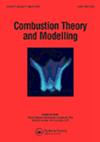用于OpenFOAM中具有详细化学的反应流模拟的改进的刚性ODE求解框架
IF 1.9
4区 工程技术
Q4 ENERGY & FUELS
引用次数: 0
摘要
在实际的燃烧模拟中,与详细化学动力学相关的刚性常微分方程(ODE)系统的积分计算要求很高。尽管有各种方法可以提高计算效率,但在算子分裂型反应流模拟中,仍有必要对基于单元的计算进行优化。在这项工作中,我们提出了一个改进的刚性ode求解器框架,旨在加快OpenFOAM中反应流的模拟。该框架结合了Radau-IIA和后向微分公式(BDF) ode集成算法,基于pyjack的全解析雅可比公式,以及基于密度的LAPACK和基于稀疏的KLU复杂线性系统求解器。我们评估了高效求解器框架在各种基准燃烧问题上的性能,这些问题涉及广泛的化学动力学复杂性。在均匀反应器中,对刚性ODE求解器的关键要素进行了全面的研究,分别关注了误差容限、积分时间间隔、雅可比评估方法和线性系统求解器对精度和效率权衡的影响。给出了一维层流火焰和三维湍流火焰较为真实的模拟结果。结果表明,在大积分区间下,Radau-IIA方法在效率和精度上均优于目前广泛使用的BDF和Seulex方法,且随着积分时间区间的减小,三种方法之间的差异逐渐减小。在所有情况下,发现对于种数在50-100左右的小型机构,全解析雅可比矩阵更有利,而对于较大的机构,建议使用近似雅可比矩阵。此外,鲁棒性更好的线性系统求解器显著提高了计算效率,其中基于密度的LAPACK求解器更适合中小型机构,而基于稀疏的KLU求解器更适合大型机构。在57种燃烧机制的真实高保真火焰模拟中,所提出的高效求解器框架在其最优配置下获得了2.6倍以上的加速。本文章由计算机程序翻译,如有差异,请以英文原文为准。
An improved stiff-ODE solving framework for reacting flow simulations with detailed chemistry in OpenFOAM
The integration of stiff ordinary differential equation (ODE) systems associated with detailed chemical kinetics is computationally demanding in practical combustion simulations. Despite the various approaches in expediting the computational efficiency, it is still necessary to optimise the cell-wise calculation in operator-splitting type simulations of reactive flow. In this work, we proposed an improved stiff-ODE solver framework targeting to speed up the simulation of reactive flow in OpenFOAM. This framework combines the Radau-IIA and backward differentiation formula (BDF) ODE-integration algorithms, the pyJac-based fully analytical Jacobian formulation, and dense-based LAPACK and sparse-based KLU sophisticated linear system solvers. We evaluate the performance of the efficient solver framework on various benchmark combustion problems across a wide range of chemical kinetic complexities. A comprehensive investigation of the key elements of stiff ODE solvers is conducted in the homogeneous reactor, focusing respectively on the influences of error tolerance, integration time interval, Jacobian evaluation methodology, and linear system solver on the accuracy and efficiency trade-off. More realistic simulation results are presented regarding the one-dimensional laminar flame and three-dimensional turbulent flame. The results indicate that the Radau-IIA is more preferable in both efficiency and accuracy compared with the widely used BDF and Seulex methods for large integration interval, whereas the differences between three methods diminish as the integration time interval decreases. In all cases, it is found that the full analytical Jacobian is more advantageous for small mechanisms of species number around 50–100 while the approximated formulation of Jacobian is recommended for larger ones. Furthermore, the more robust linear system solvers provide significant improvement on computational efficiency with the dense-based LAPACK solver being more suitable for small to moderate-scale mechanisms while sparse-based KLU being superior for large-scale mechanisms. The proposed efficient solver framework in its optimal configuration obtains more than 2.6 times speedup in realistic high-fidelity flame simulation with a 57 species combustion mechanism.
求助全文
通过发布文献求助,成功后即可免费获取论文全文。
去求助
来源期刊

Combustion Theory and Modelling
工程技术-工程:化工
CiteScore
3.00
自引率
7.70%
发文量
38
审稿时长
6 months
期刊介绍:
Combustion Theory and Modelling is a leading international journal devoted to the application of mathematical modelling, numerical simulation and experimental techniques to the study of combustion. Articles can cover a wide range of topics, such as: premixed laminar flames, laminar diffusion flames, turbulent combustion, fires, chemical kinetics, pollutant formation, microgravity, materials synthesis, chemical vapour deposition, catalysis, droplet and spray combustion, detonation dynamics, thermal explosions, ignition, energetic materials and propellants, burners and engine combustion. A diverse spectrum of mathematical methods may also be used, including large scale numerical simulation, hybrid computational schemes, front tracking, adaptive mesh refinement, optimized parallel computation, asymptotic methods and singular perturbation techniques, bifurcation theory, optimization methods, dynamical systems theory, cellular automata and discrete methods and probabilistic and statistical methods. Experimental studies that employ intrusive or nonintrusive diagnostics and are published in the Journal should be closely related to theoretical issues, by highlighting fundamental theoretical questions or by providing a sound basis for comparison with theory.
 求助内容:
求助内容: 应助结果提醒方式:
应助结果提醒方式:


